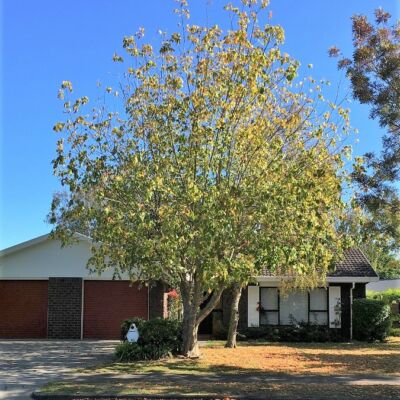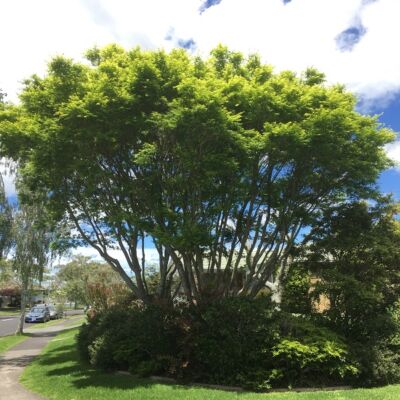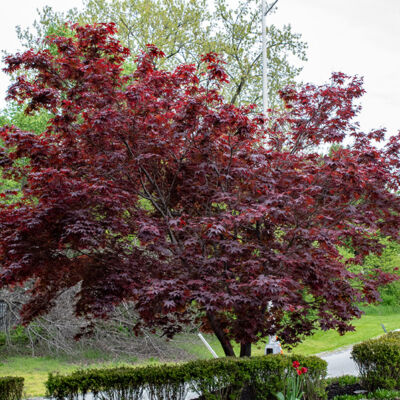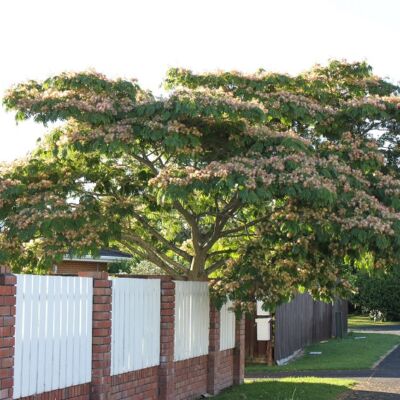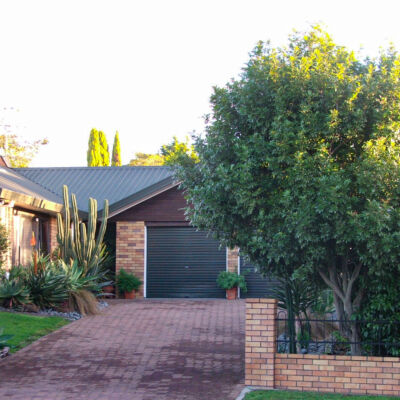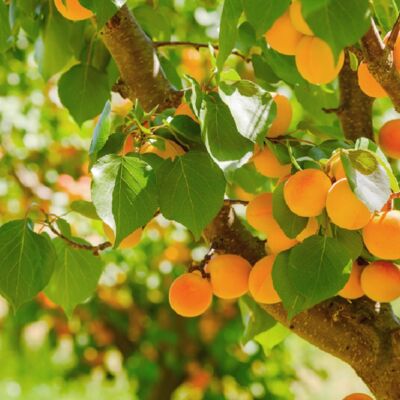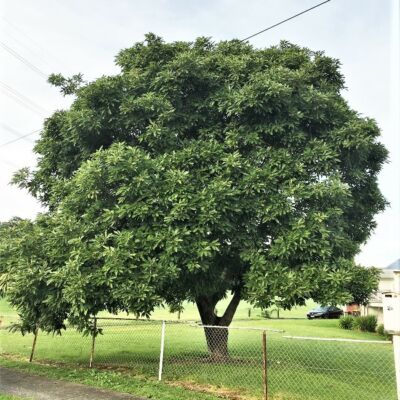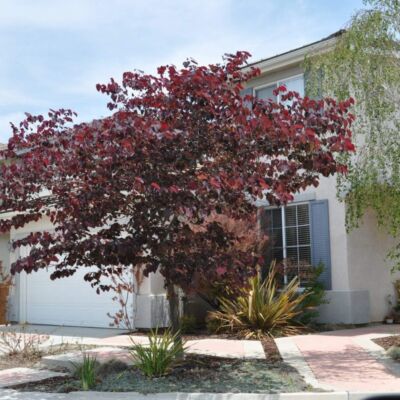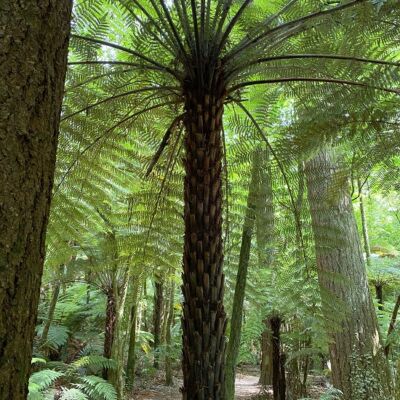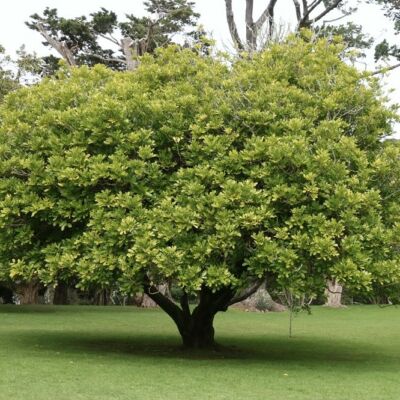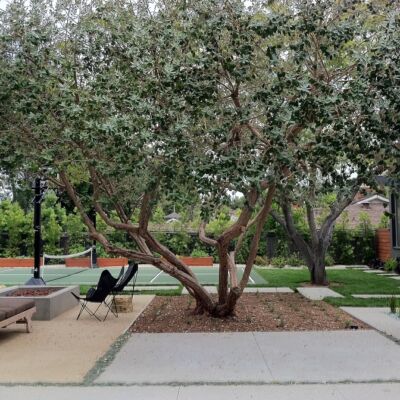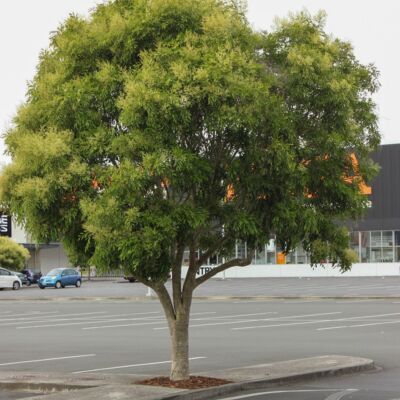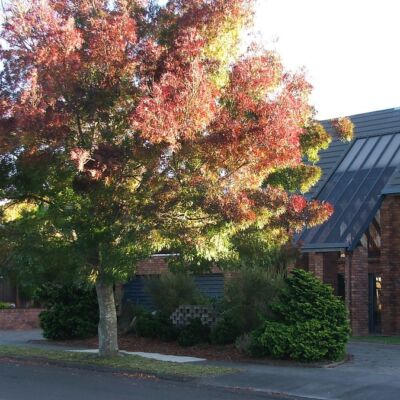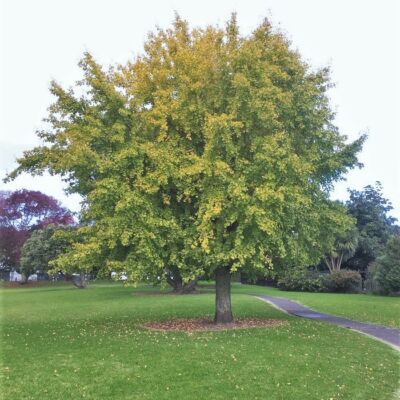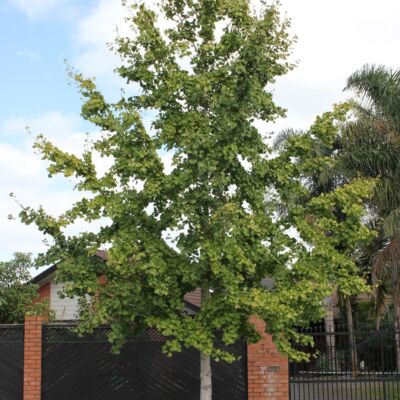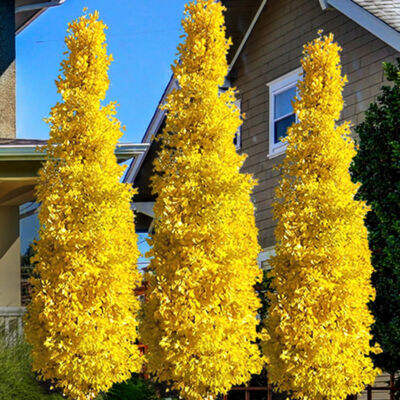|
In spring clear butter-yellow leaves emerge becoming a lime-green shade during summer. A striking small tree for spring and early summer colour. Fast growing and responds to pruning to maintain shape. Excellent shade tree. Good alternative for Ulmus (Elm Trees) in Auckland due to Dutch Elm Disease. Originates from Duncan and Davies NZ. |
| Height x Width | 6 x 4 |
| Height Range | Medium 5-10m |
| Growth Rate | Fast |
| Plant Type | Tree |
| Shape / Habit | Round |
| Country of Origin | New Zealand |
| Similar to Consider | Robinia Freesia, Ginkgo, Gleditsia Sunburst, |
|
|
| Leaf Colour | Lime Yellow |
| Deciduous Leaf Colour | Yellow |
|
|
| Flower Colour | Pink Catkins |
| Fragrant? | No |
|
|
| Specimen | Yes |
| Good Shade Tree | Yes |
| Accent | Yes |
| Note: Growth, height and grade information are given in good faith but are subject to natural variables beyond our control. | |
Sheltered Position Trees
Some trees just do a whole lot better when they’re sheltered from tough conditions, especially wind. This group will give a better show of leaves or flowers if given a bit of protection from harsh elements.
-
-
- Description
One of the most beautiful small trees for the ornamental landscape. From its young spring growth through summer the leaves are soft green. During autumn it becomes a display of colour when leaves turn brilliant shades of scarlet / yellow or orange. It is perfectly suited as a specimen tree an accent in a mixed border or in a container on the patio. Shelter from strong wind. Height x Width 5 x 4 Range Medium 5-10m Growth Rate Moderate Plant Type Tree Shape Habit Round Country of Origin Japan Similar to Consider Other Palmatum Acers, Liquidambars, - Leaf
Leaf Colour Green Deciduous Leaf Colour Orange, Red, Yellow - Flower
Flower Colour Nil - Uses
Specimen Yes Good Shade Tree? Yes Note: Growth, height and information are given in good faith but are subject to natural variables beyond our control. -
- Description
Like most Japanese maples, 'Tamuke Yama' thrives in partial shade and prefers well-drained soil. Known for its beautiful and delicate foliage, and its elegant branching structure, this cultivar is renown for its fine leaves, which turn from a rich green in the spring and summer, to beautiful shades of red or orange in the autumn. -
- Description
A quick growing, smaller, spreading tree. Rich green, ferny leaves. Flowers during summer on top of leaves, open as rounded fluffy brushes of pink. Tolerates hot dry areas once established. Excellent shade tree. Height x Width 5 x 4 Height Range Medium 5-10m Growth Rate Fast Plant Type Tree Shape / Habit Spreading Country of Origin Asia, China Similar to Consider Jacaranda, Gleditsia, - Leaf
Leaf Colour Green Deciduous Leaf Colour Brown - Flower
Flower Colour Pink Fragrant? No - Uses
Specimen Yes Good Shade Tree? Yes Note: Growth, height and information are given in good faith but are subject to natural variables beyond our control. -
- Description
One of the most popular native trees with almost black bark and glossy dark green leaves which are made up of several serrated leaflets. Sprays of rusty woolly petal-less flowers occur in early summer and present a curious reddish-brown effect. These are followed by small red fruit which attract birds. Prefers sheltered conditions in full sun in rich free-draining soil. Ideal as a specimen tree. Will grow apx 7 x 3m Height x Width 7 x 3 Height Range Medium 5-10m Growth Rate Moderate Plant Type Tree Shape / Habit Round Country of Origin New Zealand Similar to Consider Alectryon grandis, Vitex Lucens, Dysoxylum Spectabile, Planchonella costata, Myrsine salicina Leaf Leaf Colour Green - Flower
Flower Colour Red Fragrant? No - Uses
Specimen Yes Good Shade Tree? Yes Screening Yes Note: Growth, height and grade information are given in good faith but are subject to natural variables beyond our control. -
Originally domesticated in China, apricots are grown successfully around the world. These small TREES are a manageable size for the home orchard growing to around 4-5m tall. FLOWERS appear in spring with FRUIT (a drupe similar to a small peach, ranging in colour from yellow to orange) ready to harvest Dec - Feb. As they are self fruiting, you typically don't need two apricot trees to produce fruit. They are relatively easy to grow and will produce loads of fruit year after year that can be enjoyed fresh from the tree, made in to jam, bottled or dried. Apricots we supply are better suited to warmer climates. HARVEST is from Dec - Feb. Make enquiries as to which varieties we have available now or see our online catalogue.
-
A handsome, fast growing, subtropical evergreen TREE with large emerald green LEAVES that forms a thick canopy. FLOWERS September to December. FRUIT range in size and shape from round cannonball to pear like. All varieties are self-fertile though the trees will produce more and better fruit if cross pollinated. To get fruiting trees it is highly recommended to get a grafted tree and then generally require a few years to mature before fruiting. Stone grown trees may not produce fruit. Requires free draining deep soil and protection from frosts and cold winds. HARVEST September to April. from Grows Apx 6 x 4m. Make enquiries as to which varieties we have available now or see our online catalogue.
-
- Description
A small open habit tree with a broad round head. Heart shaped leaves are purple red and appear after the magenta flowers bloom on bare branches in early spring. Excellent small specimen tree suited to smaller gardens. Tolerates Clay soil but avoid wet or poorly drained soils. Deciduous. Height x Width 4 x 3 Height Range Small 1-5m Growth Rate Moderate Plant Type Tree Shape / Habit Spreading Country of Origin North America Similar to Consider Prunus Thundercloud, Fagus Riversii, Fagus Sylv Purp, Acer Tamuke Yama, Fraxinus Raywoodii, Acer Bloodgood. - Leaf
Leaf Colour Purple Red Deciduous Leaf Colour Purple Red - Flower
Flower Colour Magenta Fragrant? No - Uses
Specimen Yes Accent Yes Note: Growth, height and information are given in good faith but are subject to natural variables beyond our control. -
- Description
Iconic New Zealand native fern and the inspiration of the national Emblem. A tree fern with green-stalked soft leaves to apx 4m long that are distinctly silver on the underside. Trunk can grow to 10m tall. Prefers a more sheltered position as they generally grow under larger native NZ Trees. Height x Width 8 x 3 Height Range Medium 5-10m Growth Rate Slow Plant Type Palm Shape / Habit Palm Country of Origin New Zealand Similar to Consider Cyathea medularis, Dicksonia squarrosa, Dicksonia fibrosa - Leaf
Leaf Colour Green - Flower
Flower Colour Nil - Uses
Specimen Yes Accent Yes Note: Growth, height and grade information are given in good faith but are subject to natural variables beyond our control. -
- Description
Stout tree fern which can reach up to 6 m tall, though over a very long time, found in lowland and lower mountain forest. Distinguished by its thick fibrous, soft trunk. Fronds grow 1-2m in length forming dense crown. Dead fronds leave a tidy skirt beneath crown. While slower growing It does well in average garden conditions. This variety is suited to a sunny position or light shade. Height x Width 6 x 3 Height Range Medium 5-10m Growth Rate Slow Plant Type Palm Shape / Habit Palm Country of Origin New Zealand Similar to Consider Cyathea medularis, Cyathea dealbata, Dicksonia squarrosa. - Leaf
Leaf Colour Green - Flower
Flower Colour Nil - Uses
Specimen Yes Accent Yes Note: Growth, height and grade information are given in good faith but are subject to natural variables beyond our control. -
- Description
Wheki or Brown Ponga is a hardy NZ native tree fern. It grows a tall, slender, brown trunk to approx 6m. Fronds can reach 1.5 to 3m in length which give it the appearance of a small “umbrella” on top of the trunk. It is the most popular New Zealand tree fern which is easy to grow and maintain. Hardiness and smaller dimensions make it an excellent garden variety. Height x Width 6 x 3 Height Range Medium 5-10m Growth Rate Moderate Plant Type Palm Shape / Habit Palm Country of Origin New Zealand Similar to Consider Cyathea medularis, Cyathea dealbata, Dicksonia fibrosa. - Leaf
Leaf Colour Green - Flower
Flower Colour Nil - Uses
Specimen Yes Accent Yes Note: Growth, height and grade information are given in good faith but are subject to natural variables beyond our control. -
- Description
A handsome coastal canopy tree with bold tropical-looking leaves. Naturally found throughout the North Island in coastal forest. Waxy white flowers grow from the stems and trunk and appear March to June. Plant in deep moist soil in frost free location. Fast growing. NZ Native. Height x Width 8 x 3 Height Range Medium 5-10m Growth Rate Moderate Plant Type Tree Shape / Habit Round Country of Origin New Zealand Similar to Consider Alectryon excelsa, Vitex Lucens, Planchonella costata, Myrsine salicina - Leaf
Leaf Colour Green - Flower
Flower Colour White Fragrant? No - Uses
Specimen Yes Good Shade Tree? Yes Bird Feeding Yes Note: Growth, height grade information are given in good faith but are subject to natural variables beyond our control. -
- Description
A large deciduous tree, known for its dense foliage, elegant form, and versatility in various landscaping settings. The tree has a smooth, silver-gray bark that becomes more rugged as it ages. European beech is a great shade tree, as it forms a dense canopy with wide, spreading branches. -
A smaller growing bushy TREE it is one of the hardiest of the subtropical fruits, growing in most soils and tolerating several degrees of frost. Feijoas are commonly available as seedlings, but plants grown from cuttings or grafted specimens are more reliable. Attractive red and white FLOWERS also attract birds and are edible as well. FRUIT ripens between April and May and when mature will fall off the tree at a touch. The skin is green and ranges from smooth to rough and dimpled. The pulp is sweet and juicy with a good flavour. Generally require another to cross pollinate although "Unique" is unique in that it doesn't! They respond well to trimming if they become a little tall or woody and can also be used as a hardy hedge. APX: 4.0m - HARVEST: March-May Make enquiries as to which varieties we have available now or see our online catalogue.
-
- Description
A quick growing small ornamental tree with dark green smooth leaflets. Masses of flowers in large loose, fragrant panicles in spring almost covering the entire tree. Requires shelter in exposed areas. Easily clipped to shape. Evergreen, but can be semi-deciduous in colder areas. Height x Width 7 x 4 Height Range Medium 5-10m Growth Rate Fast Plant Type Tree Shape / Habit Round Country of Origin Asia Similar to Consider Radermacheria, Alectryon Excelsa, Myrsine Salicina, - Leaf
Leaf Colour Green - Flower
Flower Colour White Fragrant? No - Uses
Specimen Yes Good Shade Tree? Yes Screening / Shelter Yes Note: Growth, height and grade information are given in good faith but are subject to natural variables beyond our control. -
- Description
A large rounded tree with bright green leaves up to 30 cm long divided into as many as 13 leaflets. Through autumn foliage deepens to rich purple claret red tones. Excellent land-scaping street specimen or shade tree. Height x Width 15 x 8 Height Range Tall 10+ Growth Rate Fast Plant Type Tree Shape / Habit Round Country of Origin Australia Similar to Consider Prunus Thundercloud, Fagus Riversii, Fagus Sylv Purp, Acer Tamuke Yama, Acer Bloodgood. - Leaf
Leaf Colour Green Deciduous Leaf Colour Red - Flower
Flower Nil - Uses
Specimen Yes Good Shade Tree? Yes Accent Yes Note: Growth, height and grade information are given in good faith but are subject to natural variables beyond our control. -
- Description
A hardy tree of great beauty. Forms a pyramidal tree with symmetrical branches and grey corky bark. Broad fan-like leathery light green leaves resembling sections of a maidenhair fern. Spectacular autumn colouring of bright yellow over a long period. Height x Width 6 x 4 Height Range Medium 5-10m Growth Rate Moderate Plant Type Tree Shape / Habit Pyramidical Country of Origin China Similar to Consider Robinia Freesia, Gleditsia Sunburst, Acer Kellys Gold, - Leaf
Leaf Colour Green Deciduous Leaf Colour Yellow - Flower
Flower Nil - Uses
Specimen Yes Good Shade Tree? Yes Accent Yes Note: Growth, height and grade information are given in good faith but are subject to natural variables beyond our control. -
- Description
Male clone which does not have any fruits. Forms a pyramidal tree with symmetrical branches and grey corky bark. Broad fan-like leathery light green leaves resembling sections of a maidenhair fern. Spectacular autumn colouring of bright yellow over a long period. Excellent specimen tree. Height x Width 6 x 4 Height Range Medium 5-10m Growth Rate Moderate Plant Type Tree Shape / Habit Pyramidical Country of Origin China Similar to Consider Gleditsia Sunburst, Robinia fresia, Acer Kellys Gold, Acer Kellys Gold, - Leaf
Leaf Colour Green Deciduous Leaf Colour Yellow - Flower
Flower Nil - Uses
Specimen Yes Good Shade Tree? Yes Accent Yes Note: Growth, height and grade information are given in good faith but are subject to natural variables beyond our control. -
- Description
A very neat, narrowly erect form excellent for confined tight spaces. Bears usual deep green distinctive maidenhair leaves with golden tones in autumn. 'Fastigiata' is an all-male cultivar. Effective in narrow streets and small home gardens. Can also be kept trimmed for a neater appearance. Height x Width 7 x 3m Height Range Medium 5-10m Growth Rate Moderate Plant Type Tree Shape / Habit Upright Country of Origin North America Similar to Consider Quercus Robur Fastigiata, Carpinus betulus Fastigiata, Acer Bowhall, Platanus acerifolia pyramidalis. Betula var. Cupressus totem, Olea El Greco, Knightia Excelsa, Poplar crow’s nest. - Leaf
Leaf Colour Green Deciduous Leaf Colour Yellow - Flower
Flower Nil - Uses
Accent Yes Note: Growth, height and grade information are given in good faith but are subject to natural variables beyond our control.

